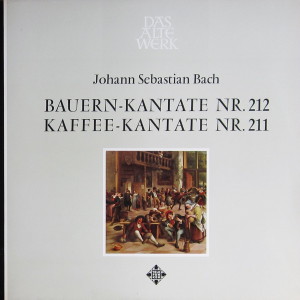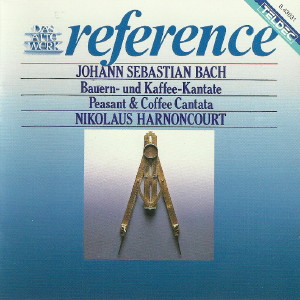 |
1 LP -
SAWT 9515-B - (p) 1968
|
 |
| 1 CD -
8.43631 ZS - (c) 1987 |
|
| Johann
Sebastian Bach (1685-1750) |
|
|
|
|
|
|
|
| Kantate "Mer hahn en neue
Oberkeet" (Bauern-Kantate), BWV 212 |
|
|
|
| für
Sopran, Baß; Flauto traverso, Corno,
Viol. I/II, Viola, Continuo |
|
|
|
| - Arie
(Duett) S.B.: "Mer hahn en neue Oberkeet" |
|
2' 51" |
A1 |
- Rezitativ
(Dialog) S.B.: "Nu, Mieke, gib dein
Guschel immer her" / Arie S.: "Ach, es
schmeckt doch gar zu gut"
|
|
1' 50" |
A2 |
- Rezitativ
B.: "Der Herr ist gut: Allein der
Schösser" / Arie B.: "Ach Herr Schösser,
geht nicht far zu schlimm"
|
|
1' 34" |
A3 |
- Rezitativ S.: "Es
bleibt dabei" / Arie S.: "Unser
trefflicher, Lieber Kammerherr"
|
|
2' 00" |
A4 |
| - Rezitativ (Dialog)
S.B.: "Er hilft uns allen alt und jung"
/ Arie S.: "Das ist galant" |
|
1' 43" |
A5 |
- Rezitativ B.: "Und
unsre gnäde Frau" / Arie B.: "Fünfzig
Taler bares Geld"
|
|
1' 27" |
A6 |
- Rezitativ S.: "Im
Ernst ein Wort" / Arie S.:
"Klein-Zschocher müsse"
|
|
7' 11" |
A7 |
| - Rezitativ B.: "Das ist
zu klug vor dich" / Arie B.: "Es nejme
zehntausend Dukaten" |
|
1' 02" |
A8 |
| - Rezitativ S.: "Das
klingt zu liederlich" / Arie B.: "Gib,
Schöne" |
|
1' 06" |
A9 |
| - Rezitativ B.: "Du hast
wohl recht" / Arie B.: "Dein Wachstum
sei feste" |
|
6' 15" |
A10 |
| - Rezitativ (Dialog)
S.B.: "Und damit sei es auch genug" /
Arie S.: "Und daß ihrs alle wißt" |
|
1' 00" |
A11 |
- Rezitativ (Dialog)
S.B.: "Mein Schatz, erraten!" / Duett
(Chor): "Wir gehn nun, wo der Dudelsack"
|
|
1' 34" |
A12 |
| Kantate "Schweigt stille,
plaudert nicht" (Kaffee-Kantate), BWV
211 |
|
|
|
| für
Sopran, Tenor, Baß; Flauto traverso,
Viol. I/II, Viola, Cembalo, Continuo |
|
|
|
| - Rezitativ
T.: "Schweigt stille, plaudert nicht" /
Arie B.: "Hat man nicht mit seinen
Kindern" |
|
3' 18" |
B1 |
| - Rezitativ B.S.: "Du böses
Kind, du loses Mädchen" / Arie S.: "Ei!
wie schmeckt der Kaffee süße" |
|
5' 22" |
B2 |
| - Rezitativ B.S.: "Wenn du mir
nicht den Kaffee läßt" / Arie B.:
"Mädchen, die von harten Sinnen" |
|
4' 04" |
B3 |
| - Rezitativ B.B.: "Nun folge,
was dein Vater spricht!" / Arie S.: "Heute
noch" |
|
8' 36" |
B4 |
| - Rezitativ T.: "Nun geht und
sucht der alte Schlendrian" / Chor
(Terzett): "Die Katze läßt das Mausen
nicht" |
|
5' 38" |
B5 |
|
|
|
|
| Rotraud
Hansmann, Sopran (S) |
|
| Kurt
Equiliz, Tenor (T) |
|
| Max
van Egmond, Baß (B) |
|
CONCENTUS
MUSICUS Wien (mit
Originalinstrumenten)
|
|
| Nikolaus
Harnoncourt, Leitung |
|
|
Luogo
e data di registrazione
|
| Vienna (Austria)
- maggio 1967 |
|
Registrazione
live / studio
|
| studio |
Producer
/ Engineer
|
Wolf
Erichson
|
Prima Edizione CD
|
Teldec
"reference" - 8.43631 ZS - (1 cd) - 56'
54" - (c) 1987 - AAD
|
Prima
Edizione LP
|
Telefunken "Das
Alte Werk" - SAWT 9515-B - (1 lp) - 56'
54"
- (p) 1968
|
|
|
Notes
|
The cantata in the
broadest sense of the word - whether
as the church cantata or thepatrician
academic or courtly work of
musical homage and festivity -
accompanied the Arnstade and
Mühlhausen organist, the Weimar
chamber musician and court organist,
the Köthen conductor and finally the
Leipzig cantor of St. Thomas' - Bach -
all through his creative life,
although with fluctuating intensity,
with interrptions and vacillations
that still are problems to
musicological research down to this
very day. The earliest preserved
cantata ("Denn du wirst meine Seele
nicht in der Hölle lassen") probably
dates, if it really is by Bach, from
the Arnstadt period (1704) and is
still completely under the spell of
North and Central German traditions.
In the works of his Mühlhausen years
(1707-08) - psalm cantatas, festive
music for the changing of the council
and a funeral work (the "Actus
tragicus") - we sense for the first
time something of whatraises Bach as a
cantata composer so much higher than
all his contemporaries: the ability to
analyse even the most feeble test with
regard to its form and content, to
grasp its theological significance and
to interpret it out of its veri
spiritual centre in musical "speech"
that is infinitely rubele and
infinitely powerful in effect. In
Weimar (1708-17) new duties pushed the
cantata right into the background to
begin with. It was not until the Duke
commissioned him to write "new pieces
monthlz" for the court services that
Bach once more turned to the cantata
during the years 1714-16, on texts
written by Erdmann Neumeister and
Salomo Franck. Barely thirty cantatas
can be ascribed to these two years
with a reasonable degree of certainty.
It is most remarkable that, on the
other and no courtly funeral music has
been preserved from the entire Weimar
period, although these must have been
a considerable demand for such works.
It is conceivable that many a lost
work, supplied with a new text by Bach
himself, lives on among the Weimar
durch cantatas.
In the years Bach spent at Köthen
(1717-23), on the other hand, it is
the composition of works for courtly
occasions of hommage and festivity
that come to te fore, entirely in
kepping with Bach's duties as Court
Conductor. It is inly during the last
few ,omths he spent ak Köthen that we
find him composing a series of church
cantatas once again, and these were
already intended for Leipzig. It was
in Leipzig that the majority of the
great church cantatas came into being,
all of them - according to the most
recent research - during his first few
years of office at Leipzig and
comprising between three and a maximum
of five complete series for all Sunday
and feast days of the ecclesiastical
year. But just as suddenly as it
began, this amazing creative flow, in
which this magnificent series of
cantatas arose, appears to have ended
again. It is possible that Bach's
regular composition of cantatas
stopped as early at 1726; from 1729 at
the latest it is evident that other
tasks largely absorbed his creative
energy, particularly the direction of
the students' Collegium Musicum with
its perpetual demand for fashionable
instrumental music. More than 50
cantatas for courtly and civic
occasions have indeed been recorded
from later years, but considered over
a period of 24 years and compared with
the productivity of his first years in
Leipzig they do not amount to very
much. We are left with the picture of
an enigmatic silense in a sphere which
has evercounted as the central
category in Bach's creative outpout.
But we only need cast a superficial
glance at the more than 200 of the
master's cantatas that have come down
to us is order to see that this
conception of their position in Bach's
total output is fully justified. Bach
has investifated their texts with
regard to both their meraning and
their wording with incimparable
penetration, piercing intellect and
unshakeable faith, wherther they are
passages from the Bible, hymns, sacred
poems by his contemporaries or
sacredly trimmed poertry for courtly
occasions. He has transformed and
interpreted these texts throygh his
music with incomparable powers of
invention and formation, he has
reealed their essence and, at the same
time, translated the imagery and
emotional content od each or their
ideas into musical images and
emotions. The perfect blending of word
and note, the combination of idea
synthesis and depiction of each detail
of the text, that joint effect of the
baroque magnificence of the musical
forms and the highly differentiated
attention to detail, the skillful
balance between contrapuntal, melodic
and harmonic means in the service of
the word and not least, the
inexhaustible fertility and greatness
of a musical imagination that is able
to create from the most feeble
"occasional" text a world of musical
characters - all this is what raises
the cantata composer Bach so much
higher than his own and every other
age and their historically determined
character, and imparts a lasting
quality to his works. It is not their
texts alone and not their music alone
that makes them immortal - it is the
combination of word and note into a
higher unit, into a new significance
that first imparts to them the power
of survival and makes them what they
are above all else: perfect works of
art.
|
|
Nikolaus
Harnoncourt (1929-2016)
|

|

|
|